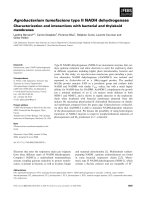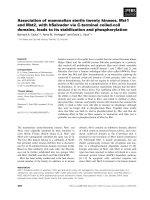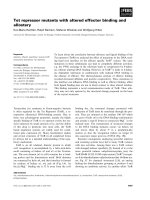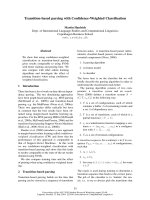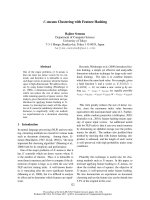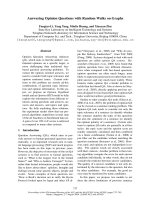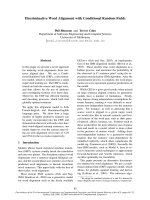Báo cáo khoa học: "Unresectable gastric cancer with gastric outlet obstruction and distant metastasis responding to intraperitoneal and folfox chemotherapy after palliative laparoscopic gastrojejunostomy: report of a case" pdf
Bạn đang xem bản rút gọn của tài liệu. Xem và tải ngay bản đầy đủ của tài liệu tại đây (337.76 KB, 4 trang )
CAS E REP O R T Open Access
Unresectable gastric cancer with gastric outlet
obstruction and distant metastasis responding to
intraperitoneal and folfox chemotherapy after
palliative laparoscopic gastrojejunostomy: report
of a case
Joong-Min Park
1,2
, Kyong-Choun Chi
1,2*
Abstract
Background: Gastric outlet obstruction (GOO) caused by unresectable gastric cancer is a challenging aspect of
patient care. There have been no reports involving patients with obstructing gastric cancer and several in curable
factors curatively treated by multimodal treatments.
Case presentation: We report a case of 55-ye ar-old man who was diagnosed with a poorly differentiated
adenocarcinoma in the pre-pyloric antrum with GOO by gastroscopy. An abdominal computed tomography (CT)
scan revealed thickening of the gastric wall and adjacent fat infiltration, and a large amount of food in the
stomach suggesting a pas sage disturbance, enlarged lymph nodes along the common hepatic and left gastric
arteries, and multiple hepatic metastases. The serum carcinoembryonic antigen (CEA) level was 343 ng/ml and the
carbohydrate antigen (CA) 19-9 level was within normal limits. The patient underwent a laparoscopic
gastrojejunostomy for palliation of the GOO. On the 3
rd
and 12
th
days after surgery, he received intraperitoneal
chemotherapy with 40 mg of docetaxel and 150 mg of carboplatin. Simultaneously, combined chemotherapy with
85 mg/m
2
of oxaliplatin for the 1
st
day and 600 mg/m
2
of 5-FU for 2 days (FOLFOX regimen) was administered
from the 8
th
post-operative day. After completion of nine courses of FOLFOX, the patient achieved a complete
response (CR) with complete disappearance of the primary tumor and the metastatic foci. He underwent a radical
subtotal gastrectomy with D3 lymph node dissection 4 mont hs after the initial palliative sur gery. The pathologic
results revealed no residual primary tumor and no lymph node metastasis in 43 dissected lymph nodes. He has
maintained a CR for 18 months since the last operation.
Conclusion: Combination chemotherapy with systemic and intraperitoneal chemotherapy following laparoscopic
bypass surgery showed marked efficacy in the treatment for unresectable advanced gastric can cer with GOO.
Background
Although survival of patients with gastric cancer after
surgery has been improved by early detection and cura-
tive surgery, the prognosis of patients with highly
advanced gastric cancer, especi ally with distant metasta-
sis such as peritoneal dissemination or hematogenous
metastasis, is usually very poor. Chemotherapy is the
treatment of choice for metastatic advanced gastric
cancer; however, a standard treatment regimen has
not been established. Neoadjuvant c hemotherapy for
advanced gastric cancer with or without distant metasta-
sis has been reported [1-4]. For patients with peritoneal
dissemination, intraperitoneal chemotherapy is an addi-
tional treatment option [1,5]; howeve r, only a few long-
term survivors have been reported after intraperitoneal
chemotherapy.
Gastric outlet obstr uction (GOO) caused by unres ect-
able antral gastric cancer is another challenging aspect
* Correspondence:
1
Department of Surgery, Chung-Ang University College of Medicine, Seoul,
Korea
Full list of author information is available at the end of the article
Park and Chi World Journal of Surgical Oncology 2010, 8:109
/>WORLD JOURNAL OF
SURGICAL ONCOLOGY
© 2010 Park and Chi; licensee BioMed Central Ltd. This is an Open Access article distributed under the terms of the Creative Commons
Attribution License ( g/licenses/by/2.0), which permits unres tricted use, distribution, and repro duction in
any medium, provided the original work is properly cited.
of patient care. Treatment of GOO is important for the
patient with unresectable gastric cancer who needs
chemotherapy. There have b een no reports involving
patients with gastric cancer and GOO and several incur-
able factors curatively treated by multimodal treatments.
In this report, we describe our experience of a patient
with unresectable gastric cancer with GOO and multiple
metastases who achieved a histologic complete response
(CR) to intraperitoneal and FOLFOX chemotherapy
after palliative laparoscopic gastrojejunostomy.
Case report
A 55-year old man visited our hospital for evaluation of
epigastric pain and poor oral intake of 2 months dura-
tion. A gastroscopy demonstrated a deep ulcerative
lesion in the lesser curvature side of the pre-pyloric
antrum and a large amount of food retained in the sto-
mach because of GOO (Figure 1A). The biopsy revealed
poorly differentiated adenocarcinoma.
An abdominal computed t omography (CT) scan
revealed thickening of the gastric wall, adjacent fat infiltra-
tion, and a large amount of food in the stomach, suggest-
ing passa ge disturbance. The CT scan also showed
enlarged lymph nodes along the common hepatic and left
gastric arteries, multiple enhancing omental masses, nodu-
lar peritoneal thickening suggestive of peritoneal carcino-
matosis, and multiple hepatic metastases (Figure 2A).
The serum carcinoembryonic antigen (CEA) level was
343 ng/ml and the carbohydrate antigen (CA) 19-9 le vel
was within normal limits. The patient was diagnosed
with unresectable gastric cancer with GOO and several
incurable factors. The clinical stage was stage IV
(cT4N2M1). The Eastern Cooperative Oncology Group
(ECOG) performance status was grade 1 [6].
The patient underwent a laparoscopic gastrojejunost-
omy for palliation of the GOO. The peritoneal drainage
catheter was placed during the laparoscopic procedure.
During laparoscopic inspection, there were several meta-
static nodules on the omentum. One of the nodule s was
biopsied and confirmed to be metastatic adenocarci-
noma. On the 3
rd
and 12
th
days after surgery, for intra-
peritoneal chemotherapy, 40 mg of docetaxel and
150 mg of carbopla tin were introduced over 2 hours in
1000ml of saline. Hyperthermia was not used in the
intraperitoneal chemotherapy. Simultaneously, he
received 85 mg/m
2
of oxaliplatin on the 1
st
day as a
2-hour infusion followed by 600 mg/m
2
of 5-fluorouracil
(FU) as a 22-hour infusion for 2 days (FOLFOX r egi-
men) from the 8
th
post-operative day repeated e very
2 weeks.
After six courses, a CT scan revealed marked reduc-
tion in the size of the hepatic metastases, and the tumor
markers returned to normal levels. A fter the completion
of nine courses of chemotherapy, the gastric wall thick-
ening, metastatic foci in the liver, omental infiltra tion of
the metastatic nodules, and enlarged lymph nodes noted
on CT scan resolved (Figure 2B). Positron emission
tomography (PET) scan showed no metabolic evidence
of mali gnancy. A gastroscopy showed an ulcerated scar
in the antrum and the GOO and passage disturbance
had also resolved (Figure 1B).
No malignant cells were detected on the endoscopic
biopsy specimen, and a CR was determined according to
the response evaluation criteria in solid tumors
(RECIST) guideline [7].
He underwent a radical subtotal gastrectomy with a
D3 lymph node dissection 4 months after the initial pal-
liative surgery. The pathologic results showed no resi-
dual primary tumor and no lymph node metastasis of
43 dissected lymph nodes. There was no peritoneal
metastatic focus in the surgical specimen including
omentum and visceral peritoneum. Postoperatively, he
Figure 1 Gastroscopy (A) before and (B) after chemotherapy.
(A) Gastroscopy demonstrated a deep ulcerative lesion in the lesser
curvature side of the pre-pyloric antrum. The biopsy specimen
showed poorly differentiated adenocarcinoma. (B) The primary
tumor had changed to an ulcerated scar. The finding of gastric
outlet obstruction disappeared.
Figure 2 Computed tomography (CT) scan (A) before and
(B) after chemotherapy. (A) A CT scan showed thickening of the
gastric wall, adjacent fat infiltration, and a large amount of food in
the stomach, suggesting a passage disturbance. Lymph nodes along
the common hepatic and left gastric arteries were markedly
enlarged, and multiple enhancing omental masses (white arrow)
and nodular peritoneal thickening, suggesting peritoneal
carcinomatosis, and multiple hepatic metastases (black arrows) are
shown. (B) Complete disappearance of thickening of the gastric
wall, the metastatic foci in the liver, omental infiltration of
metastatic nodules, and enlarged lymph nodes were observed.
Park and Chi World Journal of Surgical Oncology 2010, 8:109
/>Page 2 of 4
received oral chemotherapy with daily 600 mg of doxi-
fluridine for 12 months. He maintained a CR for
18 months after the last operation.
Discussion
The prognosis of patients with highly advanced gastr ic
cancer with distant metastasis, such as peritoneal disse-
mination or hematogenous metastasis, is usually very
poor. When peritoneal dissemination is present, curative
surgery cannot be achieved. However, aggressive treat-
ment, including cytoreductive surgery with peritonect-
omy and intraperitoneal chemotherapy, have been
reporte d for such patients [8]. Recently, Yonemura et al.
[5] developed a new multimodal treatment referred to
as bidirectional chemotherapy (neoadjuvant intraper ito-
neal-systemic chemotherapy protoco l) for the treatment
of peritoneal carcin omatosis [5]. They reported a 50%
complete cytoreduction rate by cytoreductive surgery
after neoadjuvant intraperitoneal and systemic che-
motherapy. The median survival time of all 51 patients
in that study was 14.4 months.
For bidirectional chemotherapy, various chemothera-
peutic agents have been used for intraperitoneal and
systemic chemotherapy [1,5]. For intraperitoneal che-
motherapy in the present report, 40 mg of docetaxel
and 150 mg of carboplatin were introduced, as described
by Yonemura et al.[1].
For metastatic advanced gastric cancer, S-1 plus cis-
platin was introduced as a standard treatment in Japan
based on the randomized controlled trial [9]. Oxaliplatin
has powerful anti-neoplas m activi ty, an intriguing alter-
native to cis platin with at least comparable activity, a
synergistic effect with 5-FU, and a satisfactory safety
profile. The combination of o xaliplatin with 5-FU and
leucovorin (FOLFOX regimen) was selected for systemic
chemotherapy because it has a favorable activity as first-
line therapy with locally advanced and metastatic gastric
cancer or second-line treatment in advanced or meta-
static gastric cancer patients, and may be considered a
viable treatment alternative. This regimen was suggested
tobeactivewitha40%-55%objectiveresponseratein
patients with gastric cancer [10-12]. However, this regi-
men has rarely been reported as a neoadjuvant che-
motherapy agent in the treatment of advanced gastric
cancer [13].
Neo adjuvant chemotherapeutic agents in the previous
studies included S-1 [4,5], S-1 plus cisplatin [3], metho-
trexate p lus 5-fluorouracil [1], paclitaxel plus doxifluri-
dine [2], EEP (etoposide, epirubicin, and cisplatin) [14],
and cisplatin plus 5-fluoro uracil with leucovorin [15].
The FOLFOX regimen has usually been used for palli a-
tive chemotherapy for patients with metastatic gastric
cancer. We used the FOLFOX regimen as neoadjuvant
chemotherapy, which is widely used for metastatic
advanced gastric cancer after curative or palliative resec-
tion or for unresectable gastric cancer in our institute.
In the present case, the patient had several incurable
factors, including peritoneal carcinomatosis, hepatic
metastasis, and locally advanced tumor that induced
GOO. Therefore, the first aim of treatment was pallia-
tion of the GOO symptoms. We performed laparoscopic
bypass surgery first, and at that time, an intraperitoneal
port was implanted for the following intraperitoneal
chemotherapy.
GOO is a challenging problem in p atients with
advanced gastric cancer in the distal part of the
stomach. The presence of GOO is an independent prog-
nostic factor, even after radical surgery [16]. Addition-
ally, for systemic chemotherapy, GOO is a problem that
should be treated first because adequa te oral inta ke is
essential for systemic chemotherapy. For GOO, various
treatment options, such as endoscopic stenting, pallia-
tive bypass surgery (open or laparoscopic), or palliative
resection, can be chosen. Resection is theoretically the
most effective treatmen t option for GOO by achieving
intestinal continuity and a reductive therapeutic effect.
In the present case, however, other incurable factors
existed, such as hepatic metastasis and peritoneal carci-
nomatosis. Furthermore, palliative bypass surgery (gas-
trojejunostomy) is thought to provide better l ong-term
results c ompared to endoscopic stent placement, and is
therefore t he treatment of choice in patients with a life
expectancy of > 2 months [17]. Thus, we performed
laparoscopic palliative gastric bypass surgery rather than
palliative resection or stent placement.
If curative resection is not possible or not effective,
and response to chemotherapy is expected, lapar oscopic
palliative procedure is an effective and safe procedure
option for the patient with GOO because this palliative
procedure is minimally invasive and enable the patient
to receive early post-operative chemotherapy. In addi-
tion, the port for the intraperitoneal chemotherapy can
be placed during this procedure. Furthermore, laparo-
scopic bypass surgery can prevent post-operative adhe-
sions and enable easy, definitive surgery for the patient
who has a response to the chemotherapy.
For the second operation after CR was suspected by
image study and endoscopic biopsy, we performed radical
subtotal gastrectomy with extended lymph node dissec-
tion. The aim of the surgical resection was to confirm the
CR by pathologic examination and to provide the thera-
peutic effect of resection if the residual cancer cells were
present. However, hepatic resection was not performed
because the initial hepatic metastasis was multiple and
bilobar, and the location of hepatic metastasis could not
be identified at the time of the second operation.
According to previous reports regarding neoadjuvant
chemotherapy for advanced gastric cancer, aggressive
Park and Chi World Journal of Surgical Oncology 2010, 8:109
/>Page 3 of 4
treatment for peri toneal diss emi nation has been limited
to patients with peritoneal carcinomatosis alone, rather
than hematogenous metastasis, such as hepatic metasta-
sis or distant lymph node metastasis [1,5,8,13]. D’Ugo
et al. [14] reported neoadjuvant chemotherapy in
patients w ith resectable gastric cancer. However, in the
present case, a CR was observed in spite of the fact that
he had three individual incurable factors; peritoneal dis-
semination, hepatic metastasis, and GOO caused by
locally advanced primary tumor. The reason for the
good response of our case may be related to the follow-
ing: 1) the size of the multiple hepatic metastases was
small; 2) peritoneal dissemination was limited to the
omentum and not disseminated to the distant perito-
neum; and 3) the tumor size was relatively small in spite
of GOO, and there was no adjacent organ invasion
(pancreas or colon). Thus, to evaluate the effectiveness
of chemotherapy following bypass surgery for unresect-
able gastric cancer with GOO, a large randomized con-
trolled trial is needed.
Conclusion
Combination chemotherapy with systemic and intraperi-
toneal chemo therapy foll owing laparoscopic bypass sur-
gery showed marked efficacy in the treatment for
unresectable advanced gastric cancer with GOO.
Consent
Written informed consent was obtained from the patient
for publication of this case report and accompanying
images. A copy of the written consent is available for
review by the Editor-in-Chief of this journal.
Author details
1
Department of Surgery, Chung-Ang University College of Medicine, Seoul,
Korea.
2
Chung-Ang University Yongsan Hospital, 65-207 Hangangro-3-ga,
Yongsan-gu, Seoul, 140-757, Korea.
Authors’ contributions
JP and KC equally contributed to this study and were responsible for
treatment of the case and writing the manuscript. All authors read and
approved the final manuscript.
Competing interests
The authors declare that they have no competing interests.
Received: 13 September 2010 Accepted: 20 December 2010
Published: 20 December 2010
References
1. Yonemura Y, Bandou E, Sawa T, Yoshimitsu Y, Endou Y, Sasaki T,
Sugarbaker PH: Neoadjuvant treatment of gastric cancer with peritoneal
dissemination. Eur J Surg Oncol 2006, 32:661-665.
2. Mizutani S, Oyama T, Hatanaka N, Uchikoshi F, Yoshidome K, Tori M,
Ueshima S, Nakahara M, Nakao K: Unresectable gastric cancer with
multiple liver metastases effectively treated with combined paclitaxel
and doxifluridine chemotherapy. Int J Clin Oncol 2006, 11:471-474.
3. Okabe H, Ueda S, Obama K, Hosogi H, Sakai Y: Induction Chemotherapy
with S-1 Plus Cisplatin Followed by Surgery for Treatment of Gastric
Cancer with Peritoneal Dissemination. Ann Surg Oncol 2009.
4. Mori S, Kishimoto H, Tauchi K, Higuchi K: Histological complete response
in advanced gastric cancer after 2 weeks of S-1 administration as
neoadjuvant chemotherapy. Gastric Cancer 2006, 9:136-139.
5. Yonemura Y, Endou Y, Shinbo M, Sasaki T, Hirano M, Mizumoto A,
Matsuda T, Takao N, Ichinose M, Mizuno M, et al: Safety and efficacy of
bidirectional chemotherapy for treatment of patients with peritoneal
dissemination from gastric cancer: Selection for cytoreductive surgery. J
Surg Oncol 2009, 100:311-316.
6. Oken MM, Creech RH, Tormey DC, Horton J, Davis TE, McFadden ET,
Carbone PP: Toxicity and response criteria of the Eastern Cooperative
Oncology Group. Am J Clin Oncol 1982, 5:649-655.
7. Eisenhauer EA, Therasse P, Bogaerts J, Schwartz LH, Sargent D, Ford R,
Dancey J, Arbuck S, Gwyther S, Mooney M, et al: New response evaluation
criteria in solid tumours: revised RECIST guideline (version 1.1). Eur J
Cancer 2009, 45:228-247.
8. Sugarbaker PH, Yonemura Y: Clinical pathway for the management of
resectable gastric cancer with peritoneal seeding: best palliation with a
ray of hope for cure. Oncology 2000, 58:96-107.
9. Koizumi W, Narahara H, Hara T, Takagane A, Akiya T, Takagi M, Miyashita K,
Nishizaki T, Kobayashi O, Takiyama W, et al: S-1 plus cisplatin versus S-1
alone for first-line treatment of advanced gastric cancer (SPIRITS trial): a
phase III trial. Lancet Oncol 2008, 9:215-221.
10. Lordick F, Lorenzen S, Stollfuss J, Vehling-Kaiser U, Kullmann F, Hentrich M,
Zumschlinge R, Dietzfelbinger H, Thoedtmann J, Hennig M, et al: Phase II
study of weekly oxaliplatin plus infusional fluorouracil and folinic acid
(FUFOX regimen) as first-line treatment in metastatic gastric cancer. Br J
Cancer 2005, 93:190-194.
11. Liu ZF, Guo QS, Zhang XQ, Yang XG, Guan F, Fu Z, Wang MY: Biweekly
oxaliplatin in combination with continuous infusional 5-fluorouracil and
leucovorin (modified FOLFOX-4 regimen) as first-line chemotherapy for
elderly patients with advanced gastric cancer. Am J Clin Oncol 2008,
31:259-263.
12. Cavanna L, Artioli F, Codignola C, Lazzaro A, Rizzi A, Gamboni A, Rota L,
Rodino C, Boni F, Iop A, Zaniboni A: Oxaliplatin in combination with 5-
fluorouracil (5-FU) and leucovorin (LV) in patients with metastatic gastric
cancer (MGC). Am J Clin Oncol
2006, 29:371-375.
13. Wang LB, Shen JG, Xu CY, Chen WJ, Song XY, Yuan XM: Neoadjuvant
chemotherapy versus surgery alone for locally advanced gastric cancer:
a retrospective comparative study. Hepatogastroenterology 2008,
55:1895-1898.
14. D’Ugo D, Persiani R, Rausei S, Biondi A, Vigorita V, Boccia S, Ricci R:
Response to neoadjuvant chemotherapy and effects of tumor regression
in gastric cancer. Eur J Surg Oncol 2006, 32:1105-1109.
15. Ajani JA, Winter K, Okawara GS, Donohue JH, Pisters PW, Crane CH,
Greskovich JF, Anne PR, Bradley JD, Willett C, Rich TA: Phase II trial of
preoperative chemoradiation in patients with localized gastric
adenocarcinoma (RTOG 9904): quality of combined modality therapy
and pathologic response. J Clin Oncol 2006, 24:3953-3958.
16. Park SH, Mok YJ, Kim JH, Park SS, Kim SJ, Kim CS: Clinical significance of
gastric outlet obstruction on the oncologic and surgical outcomes of
radical surgery for carcinoma of the distal stomach. J Surg Oncol 2009,
100:215-221.
17. Jeurnink SM, Steyerberg EW, Hooft JE, van Eijck CH, Schwartz MP,
Vleggaar FP, Kuipers EJ, Siersema PD: Surgical gastrojejunostomy or
endoscopic stent placement for the palliation of malignant gastric
outlet obstruction (SUSTENT study): a multicenter randomized trial.
Gastrointest Endosc 2009.
doi:10.1186/1477-7819-8-109
Cite this article as: Park and Chi: Unresectable gastric cancer with
gastric outlet obstruction and distant metastasis responding to
intraperitoneal and folfox chemotherapy after palliative laparoscopic
gastrojejunostomy: report of a case. World Journal of Surgical Oncology
2010 8:109.
Park and Chi World Journal of Surgical Oncology 2010, 8:109
/>Page 4 of 4


